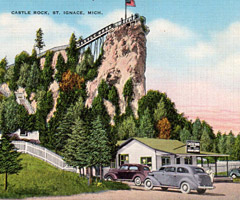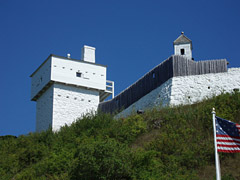History of Mackinac County
Early History
The ancient history of St. Ignace and Mackinac County will show that this was the original center of the Indian population in upper Michigan, that is, the place where the Indians congregated in large numbers. Also, it will show that this was the first French settlement which was continued – the first in Michigan and the Northwest; the original French fort was set up here; and, this was the center of the vast fur trading industry 150 years before it was concentrated in Mackinac Island (also in Mackinac County four miles from St. Ignace).
Nearly three hundred years ago, St. Ignace was the center of the fur trade which was the chief support of France’s American empire. Here trod the early fur traders, Gorseillers and Raddison; here voyaged Nicolet in his search for the way to China (1634); the footsteps of Pere Marquette and Joliet were etched in the sands of time and history on these shores. Here Cadillac founded ancient Fort DeBaude which was occupied by the French Military years before the soldiers moved to Mackinac City, Mackinac Island, and Detroit. Native Indians in this early settlement numbered fully 2,000. Descendants are numerous in this territory today. At one time the County of Mackinac or Michilimackinac as it was then called, extended from Detroit to Minneapolis, Minnesota.
Pere Marquette, “The Angel of the Ottawa Missions,” founded his chapel at St. Ignace in 1671, exactly on the spot beneath where he lies buried today. He left here to explore the Mississippi in 1673, dying near Ludington in 1675. Indians exhumed their White Father and returned him to St. Ignace where he was buried in 1677. His grave was discovered here in 1877 by the late Patrick Murray. The citizens of St. Ignace marked the spot with a modest monument which stands in Marquette’s Park today.
Statistics from 1838
The County contained 17,117,760 acres of the states total 38,732,800
According to the first Michigan Manual, by John T. Bois in 1838, the County contained 17,117,760 acres of the states total 38,732,800. In square miles, 27,688 of 57,022 as they figured. It contained most of the State north of Saginaw Bay, except Chippewa County which also was very large, 7,200 square miles, along the south shore of Lake Superior. The two comprised much more than half of the State in area.
Famous Murder Case
The Mackinac County Courthouse in 1859 was the trial site of the famous murder case of People vs. Pond reported in the 8th Vo. of Michigan Supreme Court reports, page 150 and following. It has become a precedent throughout the English Common Law world on the right of a dweller in his home to repel an assailant, by killing if necessary against an assault on an outbuilding in this case a net house. There were threats made by the assailant which a jury might find would cause the defendant to feel his life was endangered. This the trial judge did not advise the jury. Pond was convicted but the Supreme Court on appeal sent it back for retrial. Pond died before the retrial. It has become a leading case on the subject.
Historical Sites in Mackinac County
 Grave of Father Marquette, who established the Jesuit Mission here in 1671
Grave of Father Marquette, who established the Jesuit Mission here in 1671- A copy of the original painting of St. Ignatius Loyola renouncing the world. Hangs in entry of St. Ignatius church. It is believed that Bishop Baraga brought this painting here.
- Castle Rock, Ancient Lookout of Indian Chief Pontiac; site for signal fires of Algonquin Indians
- Museum in reproduction of ancient Indian fort of Algonquin Indian nation.
- Rabbits Back, natural wonder of great height. Home of Chippewa Indians and site of white man’s fishing village two centuries ago.
- Graham’s Point. Site of Indian battle and massacre. Named after John Graham who came in 1818.
- St. Anthon’ys Rock, natural stone formation in heart of city.
- Biddle House 1882 – Market Street, Mackinac
